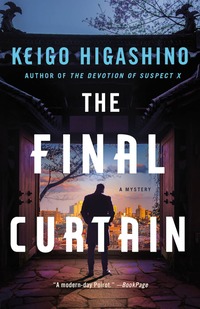The Final Curtain by Keigo Higashino
 Monday, December 11, 2023 at 4:30AM
Monday, December 11, 2023 at 4:30AM 
Published in Japan in 2014; published in translation by Minotaur Books on December 12, 2023
In The Final Curtain, the play’s the thing. The play in question, The Love Suicides at Sonezaki, was first performed in Japan in 1703. Saying that it holds the key to the mystery probably won’t spoil anything for American readers, although it might provide a clue to readers who are more familiar than I am with the history of Japanese theater. In any event, the mystery extends well beyond the play.
Keigo Higashino is the current master of Japanese mystery novels. His plots are intricate but credible. Embedded in the plot of The Final Curtain are troubled relationships between a father and daughter and between a mother and son. As is often the case, the affected children are too young to understand the difficult lives of their parents.
The novel begins with the story of Yuriko Tajima, a woman who finds a job in a small-town bar and stays there for years. She confides to the bar’s owner that she failed as a wife and mother. Perhaps she has found her niche as a waitress/hostess.
Yuriko befriends a customer named Shunichi Watabe. The nature of their relationship is a bit of a mystery to the bar’s owner. When Yuriko is found dead in her apartment, the authorities decide she had a heart attack. Her employer takes possession of her ashes. Watabe gives the bar owner the information she needs to track down Yuriko’s son, to whom the ashes rightly belong. Her son turns out to be Kyoichiro Kaga, the police detective who stars in a series of novels. The Final Curtain is the most recent, both in the original series and in translation.
Kaga isn’t much interested in the mother who walked out on him, but he is dutiful and so agrees to pick up the ashes. When he goes through his mother’s possessions, he finds a note that lists twelve Tokyo bridges, each written next to a month of the year. He doesn’t think much about it. Life moves on.
About ten years later, a woman’s body is found in a Tokyo apartment. Michiko Oshitani was strangled to death. Neither the cleaning company that employed her nor her parents know why she came to Tokyo. The apartment’s tenant, Matsuo Koshikawa, has gone missing.
Detective Shuhei Matsumiya is tasked with investigating the murder. He wonders if the murder is linked to the murder of a man who died by strangulation before his body was set on fire. The murders took place a few kilometers apart but within days of each other.
Michiko managed client relations for her employer. Matsumiya decides to interview all the businesses where Michiko had recent contacts before she traveled to Tokyo. At a retirement home, Matsumiya learns that Michiko believed she recognized an older resident as the mother of Hiromi Asai. The woman insisted that Michiko was wrong, but Hiromi lives in Tokyo, which might have given Michiko a reason to travel there.
Hiromi Asai seems to have had a tragic life. Her mother, Atsuko, felt deceived by the matchmaker who set her up with Tadao Asai. Atsuko remedied the bad marriage by walking away from her family while Hiromi was still in junior high school. As Matsumiya follows the trail of clues, he learns that Tadao jumped from a tall building, leaving Hiromi to be raised in an orphanage. Yet Hiromi Asai went on to become Hiromi Kadokura, an actress and a successful theater director in Tokyo.
When Matsumiya relates all of this to Kaga, who happens to be his cousin, he mentions a calendar on the wall of Koshikawa’s apartment. On each month, someone had written the same of a bridge. Kaga realizes the bridges and months match the note he found in his mother’s possessions.
From those roots, the mystery blossoms. It is a story of assumed identities, missing persons, and a dubious relationship between a teacher and student. Kaga is forced to confront and reconsider unpleasant memories of his childhood as he learns the truth about Michiko’s decision to leave her husband.
Kaga methodically assembles clues as he pieces together the relationship between the two strangulation victims and his mother’s possession of a list of bridges. As is customary in Japanese mysteries, the eventual solution to each puzzle makes sense. And unlike too many American crime novels, Higashino’s plot does not depend on an abundance of unlikely coincidences.
Kaga’s troubled childhood has been a collateral issue in earlier novels. This one brings the issue into focus while helping Kaga come to terms with it. Higashino always makes the drama of human existence important to the story without allowing it to overshadow the mystery. Crime novel fans who prefer the purity of a murder mystery to mindless action and shootouts might want to fill their shelves with Higashino’s novels.
RECOMMENDED
 TChris |
TChris |  Post a Comment |
Post a Comment |  Japan,
Japan,  Keigo Higashino in
Keigo Higashino in  Thriller
Thriller
Reader Comments